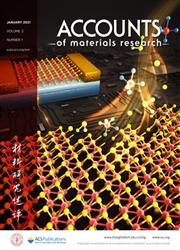Electrochemical Performance of Li Metal Anodes in Conjunction with LLZO Solid-State Electrolyte
IF 14.7
Q1 CHEMISTRY, MULTIDISCIPLINARY
引用次数: 0

锂金属阳极与LLZO固态电解质结合的电化学性能
图1所示。描述了在Li/LLZO/Li对称电池结构中与LLZO固体电解质结合的锂金属阳极的电化学循环的已发表数据。图1所示的每个数据点的详细信息可在支持信息表S1中找到。蓝色圆圈表示松下NCR18650GA锂离子电池的电化学性能,电极为6.9 mAh cm-2,放电电流密度为20 mA cm-2 (2.9 C),在300次循环中至少能保持80%的初始容量(相当于2.1 Ah cm-2的累积容量)。支持信息可在https://pubs.acs.org/doi/10.1021/accountsmr.5c00124免费获取。支持表S1 - s4和图S1, S2 (PDF)电化学性能Li金属阳极与LLZO固态电解质结合0查看0分享0下载大多数电子支持信息文件可在不订阅ACS网络版的情况下获得。这些文件可以通过文章下载用于研究用途(如果相关文章有公共使用许可链接,该许可可以允许其他用途)。如有其他用途,可通过RightsLink权限系统http://pubs.acs.org/page/copyright/permissions.html向ACS申请。Kostiantyn V. Kravchyk于2009年获得乌克兰国家科学院Vernadsky普通和无机化学研究所的博士学位。先后在法国勒芒大学、法国南特大学、瑞士苏黎世联邦理工学院和瑞士联邦材料科学与技术实验室完成博士后研究。他现在是苏黎世联邦理工学院和Empa Maksym Kovalenko教授的功能无机材料组的高级科学家。主要研究方向为全固态锂离子电池、电化学储能新概念、锂离子及后锂离子电池新材料。Matthias Klimpel于2019年获得亚琛工业大学学士学位,并于2022年获得慕尼黑路德维希马克西米利安大学硕士学位。他目前正在苏黎世联邦理工学院攻读博士学位,导师是Maksym Kovalenko教授。张焕宇于2018年获得武汉大学化学学士学位,并于2020年获得École洛桑理工学院(EPFL)化学工程与生物技术硕士学位。他目前在苏黎世联邦理工学院攻读博士学位,导师是Maksym Kovalenko教授。Maksym V. Kovalenko在乌克兰Chernivtsi国立大学学习化学,然后在奥地利林茨约翰内斯开普勒大学继续他的研究,并于2007年跟随Wolfgang Heiss教授获得博士学位。随后,他加入芝加哥大学,跟随Dmitri Talapin教授进行博士后培训(研究课题:胶体纳米晶体的无机配体盖层)。他于2011年夏季加入苏黎世联邦理工学院,担任无机化学实验室助理教授。自2020年8月起,任正教授。他的团队也隶属于Empa(瑞士联邦材料科学与技术实验室)。Maksym Kovalenko及其团队的研究活动主要集中在无机固态材料和纳米结构的化学、物理和应用方面。作者感谢瑞士国家科学基金会(No. 10.003.732)和Innosuisse (Grant No. 58207.1)的资助。本文引用了43个其他出版物。这篇文章尚未被其他出版物引用。
本文章由计算机程序翻译,如有差异,请以英文原文为准。
求助全文
约1分钟内获得全文
求助全文

 求助内容:
求助内容: 应助结果提醒方式:
应助结果提醒方式:


